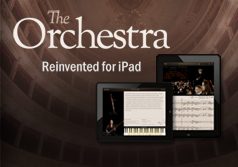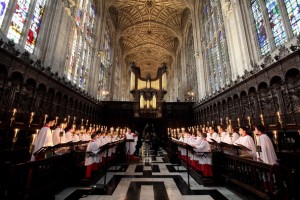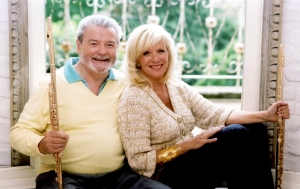2012 was a sterling year for concerts, and 2013 looks set to be even better. With the Southbank Centre’s The Rest is Noise festival dominating my diary and Britten looming large too, here is a selection of the unmissable events of the year.
Not a concert as such, but the live streaming from the Royal Opera House on 7th January promises to be a fascinating look into the day-to-day running of the company. Viewers will be able to tune into interviews, rehearsals and insights from performers and those on the creative team alike. Running from 10:30 am until 9 pm, the broadcast will offer a look into rehearsals from Verdi to Birtwistle, culminating with preparations for the evening’s performance of La bohème.
Witold Lutoslawski celebrates his centenary on 25th January. Fresh from the success of their ‘The Orchestra’ app for iPad, the Philharmonia and Esa-Pekka Salonen bring the Polish composer’s Musique funèbre and Piano concerto to the Royal Festival Hall before a complete performance of Ravel’s Daphnis et Chloé on 30th January.
February begins in style with a virtuoso programme on 1st February at Oxford’s Holywell Music Room. Michael Finnissy’s new work ‘Âwâz-e Niyâz’ is performed by the man himself with Christopher Redgate on oboe and lupophone. Also featuring Pasculli, Beeethoven and Triebensee, it is worth arriving at 6:30 pm to hear Finnissy and Redgate’s pre-concert talk.
Another unmissable event is Imogen Cooper’s Schubert recital in St John’s Auditorium on 2nd February. Holding the post of Humanitas Visiting Professorship in Classical Music and Music Education, Cooper will perform the 4 Impromptus, Sonata in A minor, 11 Ecossaises and the Sonata in D major to a rapt audience.
I will hopefully be making the journey from Oxford to London multiple times during February as the Rest is Noise festival turns to Paris. 9th February not only marks the opening of ROH’s Eugene Onegin, but a performance of George Antheil’s eclectic Ballet mécanique by the Aurora Orchestra. 20th February brings some rare gems from Les Six: Les Mariés de la Tour Eiffel arr. Marius Constant for 15 instruments, and Darius Milhaud’s Petite Symphonies Nos. 2 and 3.
The following night, the Royal Festival Hall plays host to twentieth-century music of an entirely different kind, as Unsuk Chin introduces John Zorn’s For Your Eyes Only and Angelus Novus will be performed by players from the Philharmonia under Matthew Coorey. To finish off the week, Andras Schiff and the OAE will be returning to Oxford’s Sheldonian Theatre on Friday 22nd February with Mozart and Haydn.
If their performance in December is anything to go by, the Oxford Bach Choir’s performance of Britten’s War Requiem on 9th March will be gripping. A star-studded list of performers includes soprano Elizabeth Llewelyn, tenor James Oxley and bass Giles Underwood with the Royal Philharmonic Orchestra and the Choristers of Christ Church Cathedral under the baton of Nicholas Cleobury. The Oxford Town Hall will be in for a treat!
George Benjamin’s Written on Skin runs from 8th-22nd March in the Royal Opera House. Bleak yet gripping, it is the production which I am most eagerly anticipating. London sees the return of Gustavo Dudamel and the LA Philharmonic to the Barbican Centre. I will be in the audience for the concert on 17th March (a programme of Debussy, Stravinsky and Vivier). Their trip to London will also see them perform Joseph Pereira, Unsuk Chin and John Adams on 14th March, and Adams’ The Other Gospel According to Mary (having received mixed reviews from its premiere performance).
Winner of the 2013 Grawemeyer Award, the Dutch composer Michael Van der Aa will be bringing his intriguingly titled ‘film-opera’ Sunken Garden to the Barbican from 12th April. Featuring a libretto from Cloud Atlas author David Mitchell and the first use of 3D in opera, it will be interesting to see how this multimedia production is received.
After garnering widespread critical praise with their first two CD releases, the Choir of Merton College perform a programme of Tallis, Parsons, Purcell, Tavener, Arvo Pärt and Poulenc on 3rd May. Oxford’s newest choral foundation is always a delight to watch, and a highlight promises to be a new commission by Ola Gjeilo for the Merton Choirbook (in anticipation of the college’s 750th celebrations in 2014).
I suspect that the rest of May will prove to be a write-off due to exams! However, I look forward to exploring the musical offerings in June, not least the UK premiere of Jonathan Harvey’s Wagner Dream by WNO (from 6th June).
The rest of June is focused around Britten, with my highlights based in Aldeburgh. The Aldeburgh Festival (running from 7th-23rd June) promises to rise to the occasion, but it is surely Peter Grimes on Aldeburgh Beach (15th, 17th and 19th June) which will prove the event of the year.
Monthly Archives: December 2012
The Orchestra: an impressive new app from the Philharmonia

Where can you simultaneously watch a performance, follow the score and receive commentaries of works from Haydn to Stravinsky? With the Philharmonia’s new app for iPad, as it turns out.
The Orchestra offers interaction with 8 works (six of which are excerpts and the remaining two complete movements) including conductor Esa-Pekka Salonen’s own Violin Concerto. Each work carries its own programme notes and a multitude of ways to experience each excerpt. Besides three (high-resolution) camera angles, the score can be viewed in full or as a reduction (with a version using colour-coded lines for those who cannot read music). Commentaries by selected musicians and Salonen can be added in spoken or subtitle form. The input of the musicians is particularly fascinating, lending insights into technique and highlighting the quirks of the score.
Users can also view the members of the orchestra playing at any one time by way of a diagram with coloured dots, and can even hear each section playing individually. This feature is only included with the Beethoven, but there is the option to buy the complete audio tracks for the other works if desired.
Another aspect of the app the ability to interact with the individual instruments. Besides testing the range of each instrument, the user is able to listen to a demonstration and talk by the section principal.
Bringing the Philharmonia to your fingertips, this glossy app offers hours of entertainment to anyone with an interest in music. Hopefully this will prompt many more to explore the technological niche available to classical music.
Christmas at King’s: the background to A Festival of Nine Lessons and Carols

Soon after 3pm on 24th December, a lone choirboy will send the melody of ‘Once in royal David’s city’ ringing around the fan vault ceiling of King’s College chapel. So continues a festive tradition which dates back nearly a century, and one which remains just as popular today.
The world-renowned King’s College Choir is comprised of 16 choristers, 14 choral scholars and 2 organ scholars. Dating back to the fifteenth century, the choir has garnered widespread critical acclaim. It is no surprise, then, that queues form for the Christmas Eve service from before 7:30 am, keen listeners filling the Gothic space and admiring the stained glass windows as they wait for the service to begin.
The service as we know it today was established in 1918 by Eric Milner-White (then Dean of the college). His experience as an army chaplain convinced him that a more imaginative approach to worship was needed. Milner-White’s solution to this problem was to adopt the Festival of Nine Lessons and Carols. First drawn up in 1880, this format mixes nine Bible readings telling of the birth of Jesus with carols, hymns and other choir music. After a reshuffle of the lessons in 1919, the service has been a firm fixture of the Christmas festivities ever since.
Although each service since 1919 has begun with ‘Once in royal David’s city’, the choice of carols has varied over the years. Figures including Sir David Willcocks and Sir Philip Ledger have joined Stephen Cleobury (Director of Music from 1982) in leading the service. The service has been broadcast annually by radio since 1928 (apart from 1930), with a truncated version (Carols from King’s) being broadcast in television form from 1963.
The music this year ranges from settings by Mendelssohn to this year’s new commission, Carl Vine’s setting of ‘Ring out, wild bells’ by Tennyson. The 2012 service will have been anticipated by music-lovers around the world, and I will certainly be tuning in once again.
A Festival of Nine Lessons and Carols is broadcast live on BBC Radio 4 on 24 December at 3pm (GMT). The service is also broadcast at 2pm on Radio 3 on Christmas Day, and at various times on the BBC World Service.
The Recycled Orchestra: Changing lives
The poverty-stricken town of Cateura, Paraguay is built practically on top of a landfill. With over 1,500 tonnes of solid trash arriving each day, this waste has polluted the waters of the Paraguay river and is a constant health hazard to the lives of over 2500 families who live nearby. Children are forced to work as recyclers, and often fall in with drugs and gangs.
A beacon of light amidst this distressing story is the establishment of an orchestra made entirely from scrap heap rubbish. Musician Fabio Chávez was inspired to start the orchestra after working beside the families for years (as ecological technician at the landfill). Although he started by teaching using his own instruments, he decided to experiment as enthusiasm grew.
The Recycled Orchestra is the subject of a new documentary directed by Graham Townsley. The teaser trailer is available to watch here.
A Global Christmas

A look at how music features in Christmas celebrations around the world.
The official start of the Finnish Christmas season is the first Sunday in December (although preparations begin even earlier). Another major occasion is the day of Saint Lucia on December the 13th: celebrated with candle-lit processions, this is when the tree is bought and cards are exchanged.
The musical festivities are centred on attendance of Mass, but carols and other songs are also commonly performed. An example of these is the song ‘On Hanget Korkeat Nietokset’: http://www.youtube.com/watch?v=2Z-1mWxfTyc
Since regaining independence in 1989, Romania has revived its Christmas traditions. Carolling is an important part of these customs, with the singing spreading from the children to teenagers and finally adults. Not only do these carols take place on the streets (with performers earning food and even money for their efforts), but also in concerts in churches.
‘O, ce veste minunata!’ is an example of a Romanian Christmas song: http://www.youtube.com/watch?v=TQFtTqSiKbI
Christmas for Iran’s Christian population begins with 25 days of fasting from animal products, a ritual intended to purify in preparation for the welcoming of Christ. Church services are attended during this time of fasting, but it is only after they have received Communion on Christmas Day that the fast is broken, and preparations for the Christmas feast begin.
Traditional songs are also performed during this festive season: http://www.youtube.com/watch?v=qMdj4I_nGwc
The Orthodox Church sees Russia observe Christmas on January 7th. Many of the melodies of Russian Christmas songs are drawn from elsewhere, including Bulgaria and the Ukraine. Carol singing sits beside more traditional services such as the all-night Mass.
Such a song is ‘Villancico Ruso (V lesu rodilas’ yolochka)’: http://www.youtube.com/watch?v=gkLXbNAlQGo
The festivities in Mexico are influenced by Roman Catholicism. Beginning on December 12th with the birthday of the Virgin of Guadeloupe (‘La Guadalupana’), the centre-piece of the musical celebrations are arguably the Posadas. These begin eight days before Christmas and take place every day until Christmas Eve. The Posadas comprise of a procession, the Piñata and the singing of the Letania. The Letania represents Joseph and Mary asking for accommodation, but it is only the mention of Jesus which sees them let in.
Here is part of a Posada celebration: http://www.youtube.com/watch?v=bpz7vqwj6o0
The celebrations in Australia take a different form to those we might be used to, not least because of the summer heat. Although Christmas traditions vary across the country, the candle-lit carol service on Christmas Eve is an important fixture. Such events take place on many different scales, whether broadcast from Melbourne’s Myer Music Bowl or a more intimate gathering at a local church. The services on Christmas Day begin from the early morning, culminating in a Mass later in the day.
The seasonal music also includes much lighter fare. Many Christmas carols are similar to those heard in England, but with altered lyrics to account for the difference in weather (with blue skies and sun common). ‘Six White Boomers’ is a staple of primary schools across the country, with the title referring to the kangaroos drawing Santa’s sleigh: http://www.youtube.com/watch?v=hlSsffF2xhA
My concert highlights of 2012
With the Oxford term having finished and finding myself with a bit of time on my hands, I decided to take a look back over the most memorable concerts which I’ve seen this year. In no particular order, here are my top 6:
May 19th – Harry Christophers and The Sixteen
The Sixteen’s Choral Pilgrimage saw them turn their immaculate sound to music by Brumel, Lassus and Josquin. Their carefully balanced textures and clarity of entries made for an immersive listening experience, lending a sense of intimacy to the space of Oxford’s Christ Church Cathedral. Brumel’s Earthquake Mass was a particular highlight.
June 23rd – Gustavo Dudamel and the SBYOV
As an avid fan of both Dudamel and the Simón Bolívar Youth Orchestra of Venezuela, I had booked well over a year in advance for their return to London with a programme of Britten and Beethoven. I was not disappointed. Following a headline-making appearance in Stirling with the participants of the ‘Big Noise’ scheme, this most inspiring of orchestras gave a rousing concert. The atmosphere was buzzing, and the silence of the audience after the encore of Elgar’s ‘Nimrod’ spoke volumes.
September 29th – Vladimir Jurowski and the LPO with London Philharmonic Choir and the London Symphony Chorus and soloists
Performing a programme of lesser-known Russian works (including Rodion Shchedrin, Miaskovsky and Denisov), the LPO sparkled under Jurowski in Royal Festival Hall. The orchestra excelled in their performance of these demanding works, making use of a broad range of colours. All of the players demonstrated both technical finesse and intensity of vision, making this a gripping concert.
October 12th – Sandrine Piau and Roger Vignoles
The opening concert of the 11th Oxford Lieder Festival set the bar high for the rest of the festival. In a programme including Fauré, Poulenc and Chausson, Piau’s performance was full of poise. Her subtlety was well-matched by Vignoles’ sensitive accompaniment, and the pair brought an elegant simplicity to this repertoire.
November 16th – Phantasm and Daniel Hyde
The viol consort brought a spaciousness of sound and rhythmic vitality to the music of Gibbons, Lawes and Jenkins in Magdalen College Chapel, Oxford. Imbuing sprightly passagework with an expressive quality, the programme allowed the players to show both their virtuosity and their sensitivity to nuances of mood
December 1st – Nicholas Cleobury with Oxford Bach Choir, English Chamber Orchestra and Elizabeth Atherton
Britten’s Two Psalms was given a stunning world premiere in Oxford’s Sheldonian Theatre. This early work was accompanied by an equally gripping performance of the composer’s Ballad of Heroes, and some perceptive Beethoven topped off the evening.
The Man behind the Myth: John Suchet on Beethoven
“Beethoven’s deafness is the key to understanding his life and his music.”
I am talking to John Suchet in the green room of the Holywell Music Room. John is in Oxford to promote his latest book (“Beethoven: The Man Revealed”), giving a talk as part of an evening themed around the great composer. With a small recital by Oxford Lieder Young Artists Lucy Hall and Gavin Roberts first on the programme, there is still a while before the evening begins for John to talk to me about his musical passion.
“To begin with, a long time ago, all I knew of Beethoven was the angry stuff: the man with the permanent scowl on his face and the hair flying everywhere.” But the discovery of Beethoven’s slow movements completely changed things. “Over the years I discovered this whole body of gentle, lyrical music. I thought to myself, hang on a minute: he went deaf, didn’t he? He was always angry, wasn’t he? So how did he write that?”
Beethoven’s music has become something of an obsession for John, and he describes how the composer accompanied him wherever work took him. “The greatest boy’s toy invention for me was the Walkman. I’d just become an ITN reporter in 1976 when it came out. Suddenly I could take a cassette of Beethoven with me anywhere I went. A moment I’ll never forget is when I took a ferry which left from Limassol in Cyprus at midnight for Beirut in Lebanon at the height of the Lebanese civil war. I was the only passenger on board, and we were steaming towards a red glow. I had in my pocket Beethoven’s Eroica and a battered Walkman, so I put it on. Every time I listen to that piece, I think of that moment. There’s something about Beethoven which puts your mind in the right place.”
“Beethoven: The Man Revealed” arrives at Beethoven’s music through the life of the composer. “Even if you listen to his music without knowing anything about his life, it’s amazing. But if you listen to it knowing what was going on in his life when he wrote a piece, you listen with completely different ears. Beethoven’s music is his autobiography.” He names Beethoven’s piano sonatas as a prime example of this, drawing upon the penultimate sonata (Op. 110) to illustrate this. “He sounds a chord, and he repeats it no fewer than 9 times, getting louder and louder. I think he is saying, ‘I have the one problem that a musician cannot live with (deafness), and I overcame it. That’s my message to you of future generations: you can overcome your problems.’ I know that’s a romanticised view, but that’s how I see it. I believe that Beethoven really did pour his life into his music.”
The choice of this particular piece is no coincidence: John tells me that it is “the one piece of Beethoven which I couldn’t live without”. His favourite recording of the piece is by the German pianist Jörg Demus made on Beethoven’s last piano in 1969. “After this recording was made, they covered the keys with a Perspex cover because it was now too delicate. When I bought the recording of this in the Beethoven House in Bonn, the woman who sold it to me said, ‘This is the last time Beethoven’s voice was heard’.”
I ask if any of his research had surprised him. “Yes, definitely. He’s a more ‘human’ human than most people and most books give him credit for.” He describes the layers of myth which surround the composer. “If you go and see statues of Beethoven in Europe, there are massive bronze statues and massive marble busts. He wasn’t like that at all. In fact, he was about 5 foot 6, ugly – the first girl he proposed marriage to turned him down because (in her words) he was ugly and crazy! Pock-marked face, and ill-fitting clothes that needed repair. He grew up and lived in a city at war. He had to pay his rent. He had to eat and drink. He had to buy his clothes. That’s the Beethoven that fascinates me, not the God-like creature that is normally portrayed in biographies of him.”
The process of writing the book was much shorter than anticipated. “When I started, the publisher asked how long it would take, and I said a year. He asked if I could do it in 10 months, and I said it would be impossible. I did it in 5. It was all in my head.” John tells me that there was only one new piece of research which he undertook for the book. “I found out that as a young man he took a boat trip up the Rhine with the rest of the court orchestra. Because he was the youngest member (he was 19), he was appointed kitchen scullion. Can you believe that? The great God Beethoven was kitchen scullion. Because he did so well, he was promoted to waiter. That fascinates me.” John’s trip recreated Beethoven’s journey down the Rhine, onto the River Main and down the Tauber and another little river to get to Mergentheim, where Beethoven and the rest of his orchestra played for a meeting of the Teutonic Order. “I sailed past the great rocks in the Rhine that he would have sailed past: like the Lorelei, like the Drachenfels and I saw what he would have seen because these rocks are unchanged for thousands of years. That brought me really close to the man.”
It is this quest to uncover the human side of Beethoven which underpins the talk later in the evening. John’s speech is markedly free from musicological jargon, an approach echoing that of his latest publication. “There are millions of Beethoven fans across the world who can’t read a note of music, and have no intention of doing so and don’t want to do so, but still adore his music. This book is for them.”
A Christmas carol: Christmas with Sir James Galway and the Orchestra of St John’s
Oxford Town Hall was certainly decked with boughs of holly for last night’s Christmas special. Featuring the twelve-piece Orchestra of St John’s and a carol-singing choir, the scene was set for a cosy evening away from the cold and drizzle outside. Maybe the best way to describe this concert is by comparing it to a festive CD. The performances were of mixed quality: although some were a joy to listen to, others were less gripping and faded into the background.
Take a look at the full review here.
Superlative Britten from Oxford
With his centenary year fast approaching, Saturday night’s concert was a celebration of all things Britten. The festivities have certainly begun in style in Oxford, with Nicholas Cleobury leading the Oxford Bach Choir, the English Chamber Orchestra and soprano Elizabeth Atherton in some truly outstanding music-making. Mixing works by Britten himself with those by composers who influenced him, the performances of the majority of the pieces were dynamic and committed, and certainly made for a memorable evening.
Read my full review at Bachtrack.

